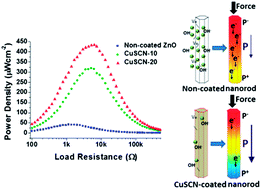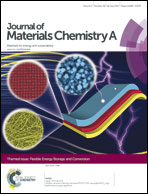Improved performance of p–n junction-based ZnO nanogenerators through CuSCN-passivation of ZnO nanorods†
Abstract
Self-powered piezoelectric systems are vital components to harvest ambient waste energy for applications such as autonomous self-powered sensors. ZnO nanorod-based devices are gaining wide attention for energy harvesters as they are easily synthesized at low temperature onto a range of substrates. However, losses related to screening of piezoelectric polarisation charges by free carriers in ZnO nanorods can significantly reduce the output of these devices. This paper reports using copper thiocyanate (CuSCN) to reduce ZnO surface-state-induced parasitic losses and improve power density of ZnO nanorod-based energy harvesters by a factor of 10. The surface modified energy harvester generated 1.07 V as an instantaneous peak open circuit voltage giving a maximum calculated 434 μW cm−2 peak power density associated with release at an acceleration of 50 g. Impedance analysis determined that the device RC time constant (τRC), correlated with device peak voltage, demonstrating a relationship between the screening effects in ZnO and τRC.

- This article is part of the themed collection: Flexible energy storage and conversion

 Please wait while we load your content...
Please wait while we load your content...